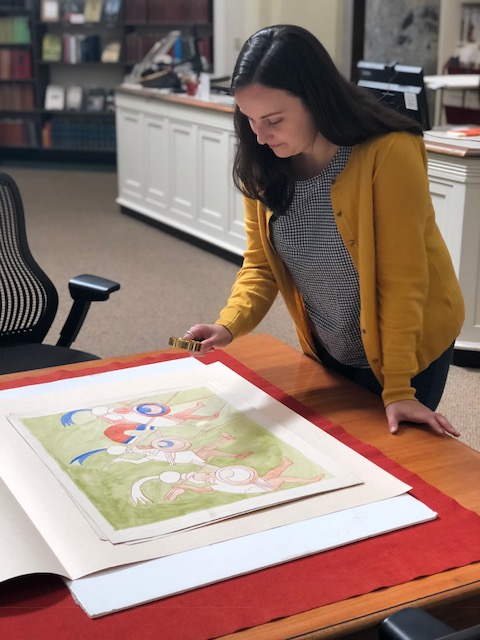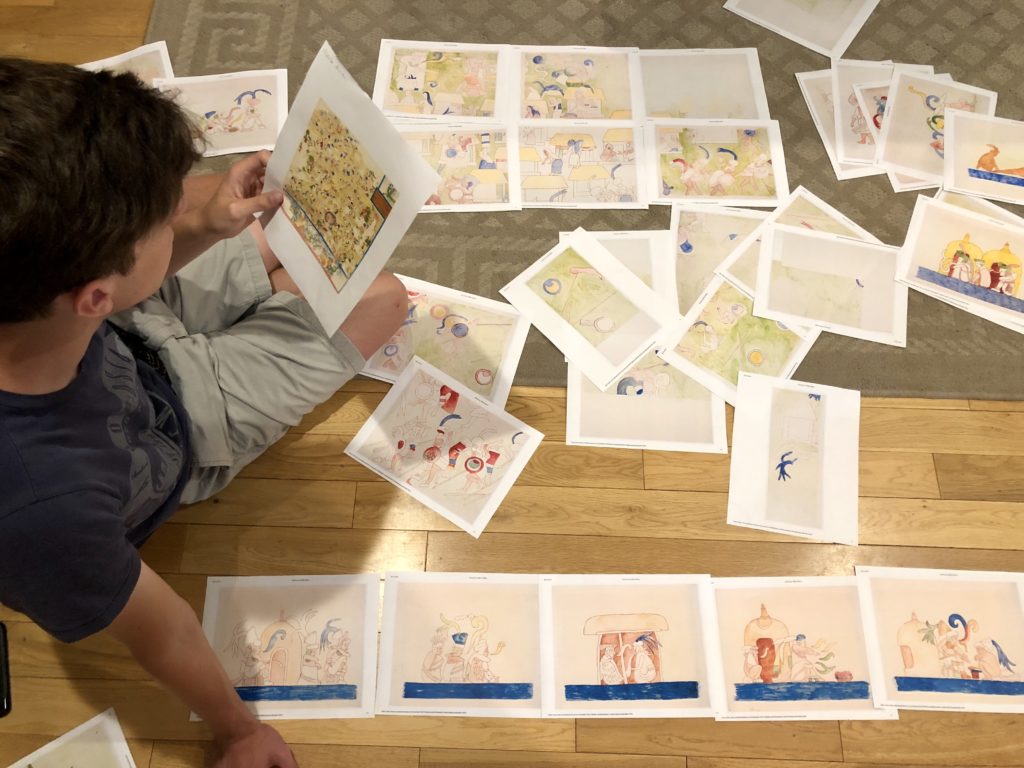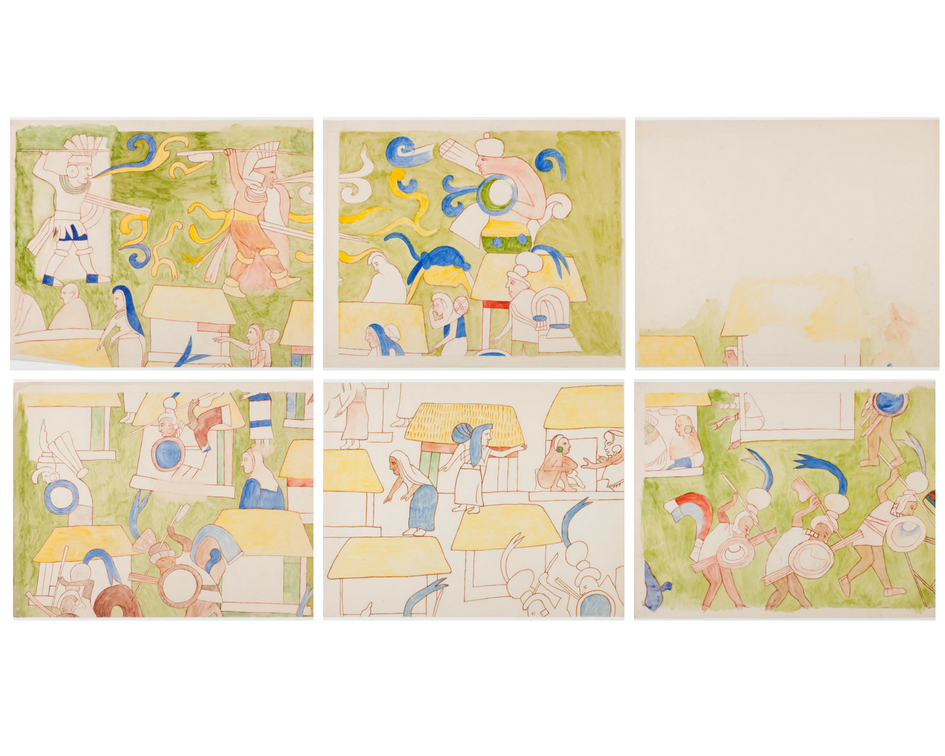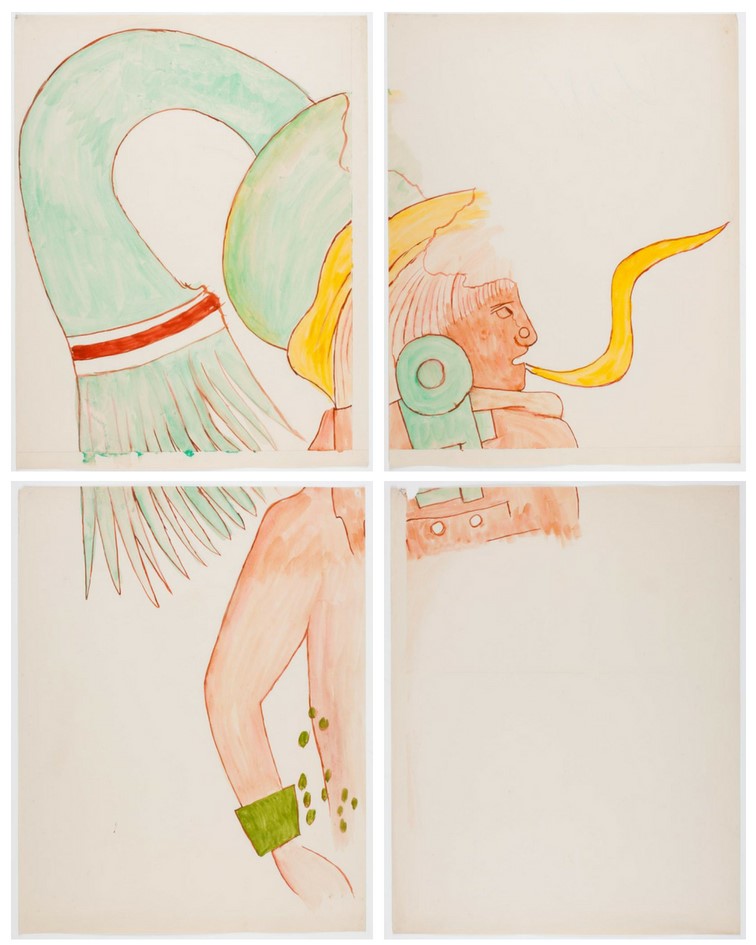Emily Isakson is a senior at Mount Holyoke College and was a Readers’ Services page this past summer. As an ancient studies major with a focus in art history and archaeology, Emily has always been interested in what has shaped the society we know today. Her time at AAS has only furthered her curiosity about the world.
My interest in the museum world has stemmed from many different places—one of which is my love of history. Though my focus is on the ancient Mediterranean, I believe that to truly understand history one must not limit oneself to a single perspective. Because of this, I find myself digging through the AAS’s collections for histories that do not come from the United States. This is how I came across the vibrant drawings of Mayan images by Worcester resident Edward Herbert Thompson.
Before the American Antiquarian Society became a research library focused specifically on collecting printed material related to pre-twentieth-century American history and culture, the Society also collected antiquities of the world and AAS served as a place where these curiosities could be interacted with and researched. When the Society’s collecting focus shifted in the early twentieth century, most of the antiquities were deaccessioned and given to places like such as the Peabody Museum at Harvard University and the Smithsonian Institution.

However, some curious items still remain in the Society’s collection (one of the most popular being the vial of tea from the Boston Tea Party). With the help of Graphic Arts Curator Lauren Hewes, I was able to uncover some of these remaining curiosities. To me, the most curious of all is E. H. Thompson’s set of mural drawings and glyph replicas, both made to scale. In this post, I’m going to focus on the mural reproductions.
Thompson, originally from Worcester, made the drawings on one of his many archaeological trips to Mexico. Thompson served as American consul for Yucatȧn in Mexico in 1885, the same year he befriended Stephen Salisbury III, who was AAS’s president at the time and also had a keen interest in archaeology. Thompson’s mural drawings were made from a building at Chichén Itzá around 1890. Chichén Itzá, a major Pre-Columbian city built by the Mayan People, is located in the Yucatȧn State and remains today one of the most visited archaeological and tourist sites in Mexico.
The drawings are important because the murals are no longer visible in their original state. Due to damage from a number of sources including archaeological excavation, exposure to nature and weather, and continuous tourism, the colors have faded and so have the pictures themselves. From the remaining evidence, the murals seem to depict an allegory of sorts—a look into daily life, war, and religion—but their meaning is up for debate. Even with information deduced from the drawings and other historical accounts, the story can mean different things to different people.
Much of the information available on what the original murals looked like is represented through Thompson’s drawings and those of one of his contemporaries, Adela Breton, an archaeologist well known for her vivid drawings of the same site. Thompson and Breton even conversed and sent letters back and forth to each other. In one letter that was reproduced in the AAS Proceedings, Thompson believed that the building the murals were in was a temple, while Breton believed it was a ball court.
I wanted to piece together Thompson’s drawings to see the recreation of the mural as a whole. By using a photograph of Breton’s painting of the same wall scenes for reference, I attempted to piece together Thompson’s drawings, which AAS has digitized. As his drawings are made to scale they are quite large, so I printed color-copies of them on 8×10” paper and fit them all together like a puzzle.

I quickly ran into some issues during this process. Thompson and Breton, even though they were painting the same mural, had different perspectives on them. There are many similarities between the two, but the main difference lies in color choice. Where Breton may use red, Thompson uses blue, etc. There is no way for me to tell what color the original was, so I am left to wonder whether when the walls were copied down the color was missing or indecipherably faded from these spots. The biggest similarities can be seen in the yellow rooftops. In my own puzzling, these rooftops stood as the main markers for putting Thompson’s drawings in order.

I ran into some other issues as well. Thompson redrew many scenes with only small discrepancies in color between the versions. He drew and redrew the same image, leading me to speculate as to why he felt he needed a second go at capturing the image. This practice, combined with the color differences between his drawings and those of Adela Breton, suggests that neither truly knew the color of certain parts of the mural. Chichén Itzá was settled in the 400s, making the site almost 1,500 years old when the paintings were created. Even at the time the mural reproductions were painted, the original murals had already begun to fade, while other areas may have already disappeared completely.

Another valuable source of information for me was the Society’s own Proceedings, where Stephen Salisbury III reported on Thompson’s findings and excavations. It appears that Salisbury funded Thompson’s trips to Yucatȧn because of his own interest in archaeology. Salisbury seemed to have a vision for the direction he felt AAS should move in. During the late 1800s, the fascination with archaeology was growing, and Salisbury was following suit with the latest trend in the academic world.
Using letters from Thompson to Salisbury in the AAS manuscript collection, I was able to find out details about Thompson’s encounters with Mayan people still living around Chichén Itzá, several of whom assisted Thompson in his excavations of the site. I also found a list of the objects and items that Thompson uncovered and sent back to America. Thompson was greatly indebted to Salisbury. He was constantly asking Salisbury for money, but always insisted he would pay it back. In 1906, almost a year after Stephen Salisbury’s death, Thompson wrote to an acquaintance that “by the direction of Mr Salisbury…who furnished me with the funds with which to take them [artifacts] out were turned over by me to the Peabody Museum.” Even after Salisbury’s passing, Thompson recognized how much was owed to him.
Regardless of the inaccuracies of his drawings, E. H. Thompson helped to contribute to preserving a visual representation of the art that once appeared on the walls of one of the Seven Wonders of the World. Alongside Adela Breton’s drawings, the pictures give amazing insight into how the Mayan people once lived and what they valued. There are still questions to be answered in terms of the accuracy of the drawings and who they should be attributed to, as in an account of her experiences in Chichén Itzá, Adela Breton mentions that Thompson hired indigenous people to create some drawings for him.* But the drawings are just one piece of the puzzle. To fully understand the drawings and Mayan culture—as with any historical topic or culture—one must look at other sources of information as well. I am fortunate to be able to work, live, and learn in environments that help to foster my understanding of the many perspectives of the past and present.
Further Reading:
American Antiquarian Society. Proceedings of the American Antiquarian Society, New Series Vol. VIII (October 1892): 262-273. Worcester: American Antiquarian Society, 1893.
Gura, Philip F. The American Antiquarian Society, 1812-2012, A Bicentennial History. Worcester: American Antiquarian Society, 2012.
*McVicker, Mary Frech. Adela Breton: A Victorian Artist Amid Mexico’s Ruins. Albuquerque: University of New Mexico Press, 2005.
Thompson, Edward H. People of the Serpent: Life and Adventure Among the Mayas. Boston & NY. 1932. Houghton Mifflin Company, The Riverside Press Cambridge, 1932.
